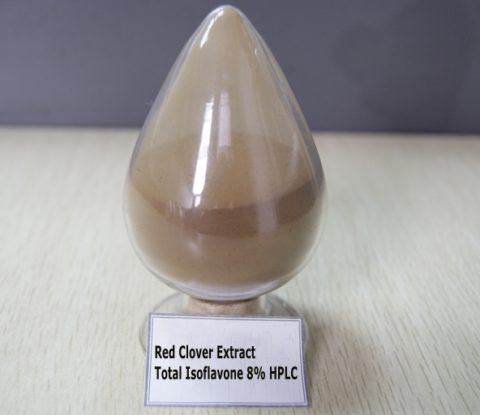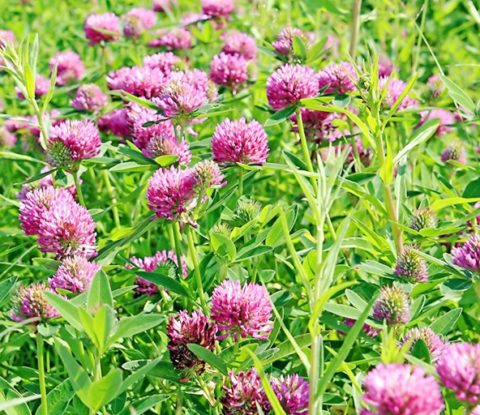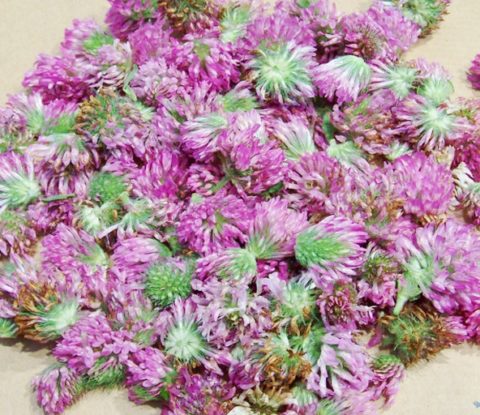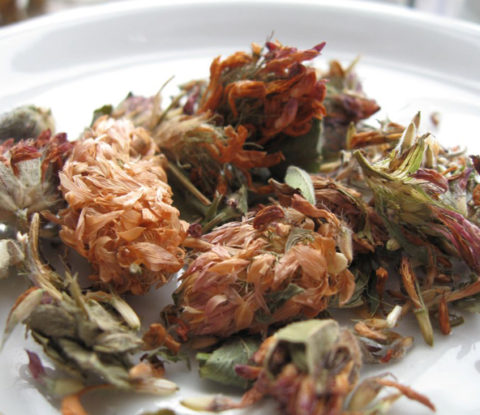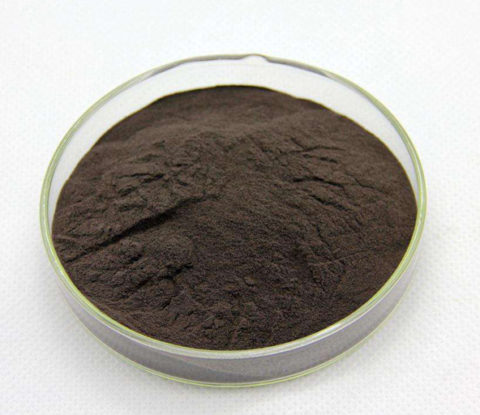
Red Clover Extract Total Isoflavone 8%, 20%, 40%, 60% HPLC, 10:1,20:1TLC
The active ingredient of red clover extract is isoflavone. Compared with other phytoestrogens, the activity of estrogen is higher. It plays an important role in preventing breast cancer, prostate cancer, colon cancer, improving osteoporosis and improving menopausal symptoms of women.
Red Clover Extract Total Isoflavone 8%-80% HPLC, 10:1,20:1TLC
【Latin Name】: Trifolium pretense L.
【Part Used】: Leaf&flower
【Specification】: Total Isoflavone 8%, 20%, 40%, 60% HPLC, 10:1,20:1TLC
【Appearance】: Brown or dark brown powder
【Active Ingredient】: Biochanin A,Formononetin,Ononin,Genistein
【Cas No.】:
Biochanin A CAS Number:491-80-5
Formononetin CAS Number:485-72-3
Ononin CAS Number:486-62-4
Genistein CAS Number:446-72-0
【Benefits】: Estrogen supplement
【Storage】: Store in cool dry place and keep from direct light
【Shelf life】: 2 years when properly stored
【Packing】: Fiber drum (25kg/drum); aluminum foil bag and carton box(less than 10kg)
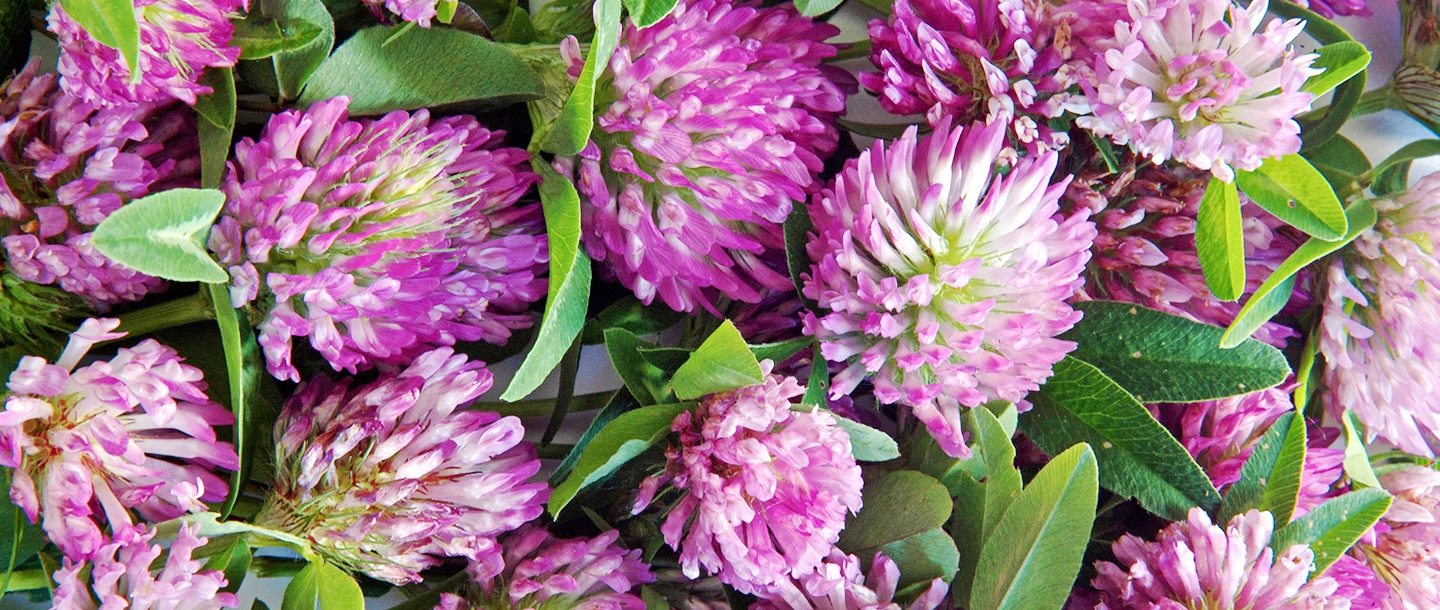
Red clover extract contains an impressive array of vitamins and trace minerals in synergy with many active medical compounds, including a strong concentration of isoflavones. Isoflavones are a type of flavonoids found in plants that act like estrogen in mammals. These isoflavones are also found in many plants in the (FABACEAE) or pea family like soybeans, red clover, alfalfa, garden peas, beans,licorice and kudzu. These phytoestrogens exert a weak estrogenic effect due to their ability to bind estrogen receptors. This is of special interest to women in relieving the symptoms of menopauseand providing protection against osteoporosis by helping to maintain bone density. These compounds have shown promise in studies for their protective effects against cancer of the breast. Red clover maintains a strong following among traditional herbalists as a blood purifying depurativethat has been used safely and effectively for hundreds, if not thousands of years in clinical practice. Red clover has been used traditionally to treat respiratory and skin problems such as cases of childhood eczema, and can be effective for other chronic skin conditions as well.
Benefits of Red Colver Extract
1. Diabetes Help
Some individuals with type II diabetes may benefit from red clover extract. Although this herbal medicine did not show any influence on the diabetes itself, many of the common complications of diabetes such as arterial narrowing may be improved in some by taking this herb.
2. Increased Blood Circulation
Red clover, whether it is taken as an extract, a tincture, or in red clover tea, will help improve blood circulation and minimize problems due to poor circulation. This is also a common problem with diabetes, and this causes a number of applications each year.
3. Hormone Replacement Therapy
Red clover extract contains phytoestrogens and isoflavones which can be used naturally to replace hormones as women age. Hormone replacement therapy is very controversial, with some experts advising against it and some experts recommending it. Some women claim that this herbal medicine helps with hot flashes and other common hormonal imbalance symptoms.
4. Detoxification
One of the biggest red clover benefits is that this herb will help detoxify your body and eliminate any built up chemicals and toxins.
5. Prostate Cancer Help
In the laboratory a number of isoflavones which are present in red clover extract have been shown to have cancer fighting properties, but more research is needed on the effects in humans before this treatment is recommended by many physicians.
6. Lower Cholesterol Levels
One of the beneficial red clover extract side effects is that this herbal medicine may help to lower your cholesterol levels. Some scientific studies have been done on the effects that red clover has on cholesterol, but there is not enough evidence yet to definitively prove this link.
7. Treat Osteoporosis Naturally
Osteoporosis is another condition that may benefit from using red clover extract, And this is also due to the isoflavones which are contained in this herbal medicine. Because the isoflavones act as a phytoestrogen it is possible that regular use of red clover could lead to increased bone density and minimize the risk of osteoporosis.
8. BPH Remedy
One of the most common red clover herb uses is as an herbal medicine to treat benign prostatic hypertrophic, also commonly called BPH. There has not been enough scientific studies done to say one way or another, and a number of experts contradict each other on whether or not red clover can help treat BPH.
9. Diuretic Properties
Red clover extract has diuretic properties, and can help increase your urine output. This can be beneficial if you are bloated from your menstrual cycle or are retaining water for any other reason.
10. Anti-Inflammatory
One of the most popular reasons to buy red clover extract Is that this herb has been used as an anti-inflammatory for many years.
Researches on Pharmacological Benefits of Red Clover Extract
Interactions with Hormones
Estrogen
There are three receptors known as ‘estrogen related receptors’ (ERRs) consisting of the isoforms of ERRα, ERRβ, and ERRγ; these steroid hormone receptors have a large structural homology to estrogen receptors, but are not activated by endogenous estrogens (they appear to be constituitively active without a ligand). These receptors have a smaller binding pocket for ligands than do the estrogen receptors and it appears that they may respond to some flavonoids such as biochanin A which activated all three subsets (10µM) with nonsignificantly greater potency than daidzein (one of the Soy Isoflavones) by enhancing the ERR affinity to the coactivator PNRC. It is thought that ERRs are involved in estrogen signalling (uncertain how) since ERRα and ERRγ are negatively and positively associated with good biomarkers in breast cancer, respectively.
When looking at the level of estrogen signalling, Promensil in isolated BT-474 cells was able to signal through the estrogen receptors when used at a 10-fold diluation (from a basic stock solution) weakly at 100-fold and nothing at 1,000-fold. Isolated irilone, a minor catchol isoflavone, appears to exert estrogenic properties in vitro. It is thought that there are direct estrogenic effects in humans since oral supplementation of 80mg isoflavones from red clover over 90 days in menopausal women appears to improve vaginal cytology including karyopyknotic, cornification and basal cell maturation indices; indicative of estrogenic effects. This failure has been replicated elsewhere and when measuring breast density (another biomarker of in vivo estrogenic effects) there are no whole-group effects with 40mg Promensil over the course of one to three years, although there may be a minor antiestrogenic effect assessed by reduced breast density in women overexpressing the estrogen receptors (ESR1 genotype) but not necessarily in women with a family history of breast cancer.
Despite the above (which used the Promensil extracts of Red Clover Extract), one extract known as Menoflavon has been noted to have estrogenic effects in vaginal tissue at an equivalent dose (80mg daily) although said study was funded by the producers of Menoflavon and another study (independent) using this extract actually noted a decrease in endometrium thickness associated with no changes in estrogen and a 22% increase in testosterone.
In postmenopausal women given 80mg of red clover isoflavones daily for 90 days, there appears to be no significant influence on circulating 17β-estradiol concentrations relative to placebo and this failure noted elsewhere and with 40mg over the course of three months to a year.
Testosterone
When tested in vitro, Promensil has been noted to have an androgen antagonistic action (63% when incubated with a 10-fold dilution of stock solution) with no appreciable agonistic activity; Promensil failed to interact with progesterone receptors. In postmenopausal women given 80mg of red clover isoflavones daily for 90 days, no significant influences on testosterone are noted relative to placebo which has been noted with 40-80mg over the same time period elsewhere. One lone study with MF11RCE at 40mg twice daily has noted an increase in the testosterone concentrations of menopausal women by 22% associated with less of a decline in LH seen in placebo, but this occurred without changes in any other hormonal parameters.
Follicle Stimulating Hormone
In postmenopausal women given 80mg of red clover isoflavones daily for 90 days, FSH appears to be unaffected.
Luteinizing Hormone
In postmenopausal women given 80mg of red clover isoflavones daily for 90 days, there doesn’t appear to be any influence on LH concentrations in serum.
IGFs
IGF proteins are involved in the pathology of colon cancer somewhat, as they generally promote normal and cancerous cell growth and higher circulating IGF levels are seen in persons with colon cancer relative to normal controls and while the major binding protein (IGFBP-3; sequesters up to 90% of bound IGF) is not the less active IGFBP-1 and IGFBP-2 appear to be.
One pilot study in otherwise healthy women noted that red clover (Promensil, 40mg capsules twice daily for a month) there was a nonsignificant trend to reduce IGF-1 concentrations in premenopausal women which was not present in the whole group (including postmenopausal women) and at no time was there an influence on binding proteins (IGFBP-1 and IGFBP-3).
A study using Promensil capsules (40mg) with breakfast and dinner over the course eight weeks in men with a family history of colorectal cancer, supplementation failed to alter circulating levels of insulin like growth factors (free IGF-I, total IGF-II, IGF binding proteins 1-3) when assessing the whole group but in men designated as equol producters (23% of the sample) there was a 15.1% decrease in total IGF-1 (4.1-27.2% range). Serum IGF levels negatively correlated with equol, but not with genistein and elsewhere in a sample of women with a family history for colorectal cancer there was still a failure of 40mg Promensil twice daily to influence circulating IGFs or their binding proteins, with confirmation that the mRNA levels for IGF in colonic tissue were similarly unaffected but there was a large variation seen in IGFBP-2 levels and while that study did not measure equol production it has elsewhere been noted to positively correlate with other binding factors such as IGFBP-3.
Sexuality and Pregnancy
Menopausal Symptoms
Supplementation of 80mg of the red clover isoflavones appears to reduce postmenapausal symptoms after 90 days as assessed by the Kupperman index by 78%, whereas placebo experienced a 23% reduction over the same time period with a similarly structured study using 80mg isoflavones noted a reduction in menopausal symptoms as assessed by the Kupperman Index (75.4%) as well as both hot flashes and night sweats (72.2-73.5%) relative to placebo, and this benefit was not observed three months after supplement cessation.
40mg of red clover isoflavones daily for twelve weeks has been noted to reduce hot flashes when measured at four weeks, but over the full course of the study there was a failure to reduce overall menopausal symptoms or hot flashes relative to placebo and this failure was then replicated when using 40-160mg Promensil and assessing hot flashes (29-34% reduction; placebo noted a 35%) or overall symptoms (26-44% reduction whereas placebo reached 46%).Using Promensil at this dose (40mg) over the course of a year does not appear to confer protective effects either, even if controlled for urinary isoflavones or genotypes (CYP19, CYP17, ESR1) and the 40-120mg dosage range of red clover isoflavones has failed elsewhere over a year where the reduction in symptoms seen (Kupperman Index) were similar to placebo.
At times the brand Promensil is used (red clover isoflavones paired with Soy Isoflavones), and when using this supplement it appears that supplementation of 80mg is able to significantly reduce hot flashes by 33% (placebo unchanged) within three weeks which increases to a 44% reduction after 12 weeks. Overall, menopausal symptoms as assessed by Greene Climacteric Scale (12.8% reduction) were improved relative to placebo although this has not been noted elsewhere with the same dose and time frame.
One study has noted that, despite no overall benefits at the end of the 12 week intervention seen with supplementation of 80mg Promensil, that there was a quick decline in hot flashes in the early parts of the trial in supplementation only; another study with a 4-week placebo run in before Promensil supplementation noted that the expected drop occurred within 1-3 weeks (33% from baseline, greater than placebo) suggesting an acute effect that fades with time. Elsewhere, while many studies note that supplementation can increase urinary isoflavones and said increase in variabile from one subject to another that urinary isoflavones may not be correlated with individual benefits; instead, subjects who are overweight may be more likely to see benefits.
Neurology
Anxiety
One study using a red clover extract at 398mg (120mg isoflavones) daily for one year in postmenopausal women noted that supplementation was associated with reductions in anxiety after one year, but not after three months and not alongside improvements in any other menopausal symptom. This was later expanded on with supplementation of 80mg isoflavones (MF11RCE) but over 90 days in a study funded by the aforementioned supplement’s producers, but supplementation was associated with a significant reduction in anxiety assessed by the Hospital Anxiety and Depression Scale (HADS) reaching 76.9% alongside reductions in depressive symptoms (former scale plus Zung’s Self Rating Depression Scale; SDS) by 78.3-80.6%. These effects are somewhat in line with the effects on quality of life in postmenopausal women, as one study using 80mg of the isoflavones daily for a period of 90 days noted a significant improvement in self-rated mood (on a 0-100 VAS rating scale, the improvement reached 66-68 points whereas placebo increased 8-15) although a later study assessing quality of life via MENQOL noted that the reduction was lesser in magnitude and not significantly different than placebo.
Cognition
In postmenopausal women over 60 given Rimostil (formononetin rich isoflavone extract) daily for six months, there appeared to be an improvement in the block design test relative to placebo (visuospatial reasoning) with impairments in digit span and verbal memory testing, and most other cognitive parameters being unaffected.
Cardiovascular Health
Blood Flow
Supplementation of 40-80mg of red clover isoflavones for five weeks in otherwise healthy postmenopausal women appears to increase arterial compliance by up to 23% as assessed by ultrasound, and this occurred without any changes in blood pressure. It was later expanded upon and arterial stiffness measured again, and red clover isoflavones were again able to reduce stiffness (assessed by arterial compliance and pulse wave velocity) without any effect on blood flow (assessed by flow mediated vasodilation) nor blood pressure. One study where an increase in blood flow noted, however, used 50mg isoflavones from red clover (predominately formononetin) in postmenopausal women with type II diabetes which coincided with a decrease in blood pressure.
Atherosclerosis
It was noted that formononetin, by itself, was able to reduce circulating VCAM-1 concentrations by 11% relative to placebo in postmenopausal women and older men. It has been noted that dietary isoflavone intake is negatively correlated with serum homocysteine concentrations in premenopausal women but when testing 86mg of red clover extract daily supplementation has failed to significantly influence serum homocysteine or folate concentrations over the course of four menstrual cycles.
Blood Pressure
Supplementation of 80mg red clover isoflavones daily for 90 days in menopausal women, despite improving symptoms of menopause, failed to influence blood pressure and this failure has been noted elsewhere but may not apply to type II diabetics, as one study in postmenopausal women with type II diabetics given 50mg of the isoflavones daily for a period of four weeks was able to reduce systolic (8mmHg) and diastolic (3.4mmHg) blood pressure relative to control.
Triglycerides
Triglycerides appear to be slightly attenuated over 90 days in postmenopausal women given 80mg of the isoflavones (9%, although there was an increase in placebo) which was replicated elsewhere to a similar degree in postmenopausal women (9.7%) but has failed to affect a sample of older men and women given the same dose or in premenopausal women given 80mg for three menstrual cycles. One study noting a minor decrease in triglycerides barely reaching significance (9.7% reduction) noted that the results were significantly larger when controlled for women with baseline triglycerides over 178mg/dL; the reduction being seen with 40mg Promensil twice daily (33%).
Cholesterol
Biochanin A appears to signal via one of the estrogen receptor subsets (ERα) to induce apolipoprotein A1 mRNA synthesis (reaching 600% of control), with activity at concentrations as low as 500nM and exerts maximal effects at 10µM, with 500-1,000nM biochanin A being comparable in potency to 1nM 17β-estradiol (300% above control). This signalling was dependent on the estrogen receptor alpha (ERα), since it was replicated in HepG2 cells made to express this receptor (which they normally do not) while expressing ERβ only failed to respond to biochanin A. This mechanism also occurs with genistein, a metabolite of biochanin A. Oral ingestion of 40mg isoflavones (Biochanin A and Formononetin in a 3.5:1 ratio) twice daily over the course of six weeks has been noted to reduce LDL cholesterol by 9.5% in men but not women, although this study noted that the intervention group trended (nonsignificantly) to have a higher baseline LDL concentration with men. This same dose has elsewhere failed to influence LDL, HDL, and total cholesterol in postmenopausal women over 90 days to a year and a failure has been noted in premenopausal women given the supplement over three menstrual cycles where all subsets of HDL (HDL, HDL2, and HDL3) as well as Apolipoprotein A were unaffected. Apolipoprotein A has been once noted to be reduced in overweight, but nor normal weight, postmenopausal women with supplementation of red clover extract (MF11RCE) at 80mg over 90 days.
There have been some positive studies with Red Clover supplementation, but are usually low powered pilot studies or lacking a placebo control despite blinding with only one study with a blinded control noting an increase in HDL-C (18.1%).When looking at well controlled positive studies, one conducted over the course of one year in otherwise healthy postmenopausal women given 40mg of isoflavones once daily noted a 21% increase in HDL-C within three months which persisted at the same magnitude until a year of supplementation and another study (failing to note an increase in HDL-C) noted an improvement in LDL and total cholesterol only in overweight postmenopausal women.
In women diagnosed with high cholesterol (mild to moderate; 5-9mM), supplementation of red clover isoflavones at 40-80mg for 12 weeks after a four week run-in period noted that supplementation failed to reduce any cholesterol biomarker relative to control.
Interactions with Glucose Metabolism
Type II Diabetes
While in otherwise healthy premenopausal women there is no influence of red clover supplementation in insulin resistance at 80mg over the course of three menstrual cycles and isoflavones in general (usually referring to the Soy Isoflavones tend to be associated with less insulin resistance over three months, 40-80mg of red clover extract (Promensil) daily in postmenopausal women was associated with a decrease in insulin sensitivity as assessed by QUICKI after three months (despite the estrogen patch control being insulin sensitizing and no influences of isoflavones on hormones).
Fasting blood glucose, insulin, and HbA1c have been noted to be unaffected by supplementation (50mg isoflavones, mostly formononetin, daily over four weeks) in type II postmenopausal diabetics.
Obesity and Fat Mass
Adipogenesis
100-1,000nM of Biochanin A in isolated stem cells derived from adipose tissue (ADSCs) in a growth medium over the course of 12 days has been noted to reduce the formation of adipocytes (33.6%) in a concentration dependent manner to 20.7-27.3%, which was due to promoting differentiation of ADSCs into osteoblasts with greatest potency at 300nM.
Fat Mass
While fat mass per se is not frequently measured, overall weight has been measured in numerous trials on supplementation of red clover extract in postmenopausal women; there appears to be a unanimous failure for red clover extract to reduce weight in these subjects even when supplementated at the higher end (80mg) for up to a year.
